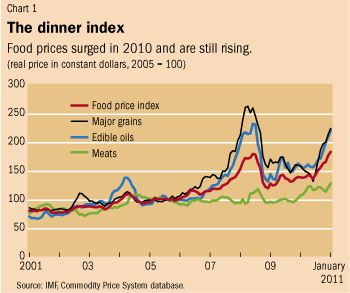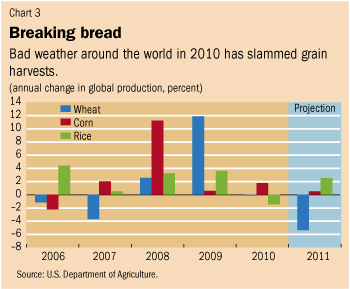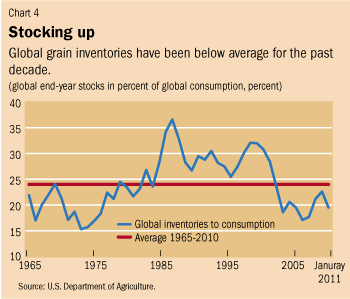Thomas Helbling and Shaun Roache (2011) argue that higher food prices are here to stay not because of weather factors, but due to the ongoing structural change in international food markets. The weather-related supply shocks will normalize after production increases during favorable weather conditions. But, what will be hard to change is the fact that consumers in emerging and developing countries are getting richer and changing their diet, particularly eating more high-protein foods such as meat, dairy products, edible oils, fruits and vegetables, and see food. These products are more income elastic than staple grains. So, supply adjustment to the structural increases in demand for major food commodities will take more time than adjustments related to weather-related supply shocks. Improved technology and higher yield growth could compensate for the such scarcity in the long term. But, for the short term, higher food prices could find a new normal that is higher than previous thought.

What is causing the rise in food prices?
- Food is not traded as extensively and readily as manufactured goods, because of protectionist agricultural policies. Since most food is not traded, international food prices are only one determinant of domestic food inflation.
- Structural changes in diet in emerging and developing countries, i.e. more consumption of meat, and more demand for animal feed to rear cattle.
- Increasing use of food grains to produce biofuels. High oil prices and policy support (for production of biofuels) have boosted demand for biofuels. In 2010, the production of corn-based ethanol absorbed 15 percent of global corn crop. Meanwhile, high oil prices directly increase cost of production of food because fuel is used to produce inputs such as fertilizers.
- Over the past decade, global productivity growth (the amount of crop produced per hectare) has fallen for rice and wheat compared with the 1980s and 1990s. Ceteris paribus, less productivity growth means higher prices. For farmers, average prices have to increase to provide enough incentives for increased supply. But, with lower yield growth, production increases have to come from using more land (higher acreage). Meanwhile, low yield growth and limited land availability amid rapid demand growth could lead to shifts in international trade patterns.

- Food prices are pushed up due to a series of weather-related supply shocks since mid-2010. Droughts and wildfires decreased wheat production in Russia, Ukraine, and Kazakhstan; a hot and wet summer led to lower-than-expected corn harvest in the US; and La Nina weather episodes hit rice production in Asia. Worse, shortfall in production led to the imposition of grain export restrictions in Russia and Ukraine. Patterns of protectionist trade policy has been observed after the supply shocks.
- Stock-use ratio (stocks relative to consumption) are low, causing food price volatility. Reluctant inventory holders withhold release of grains due to fear of future shortages, thus affecting food supply and prices in the market.
